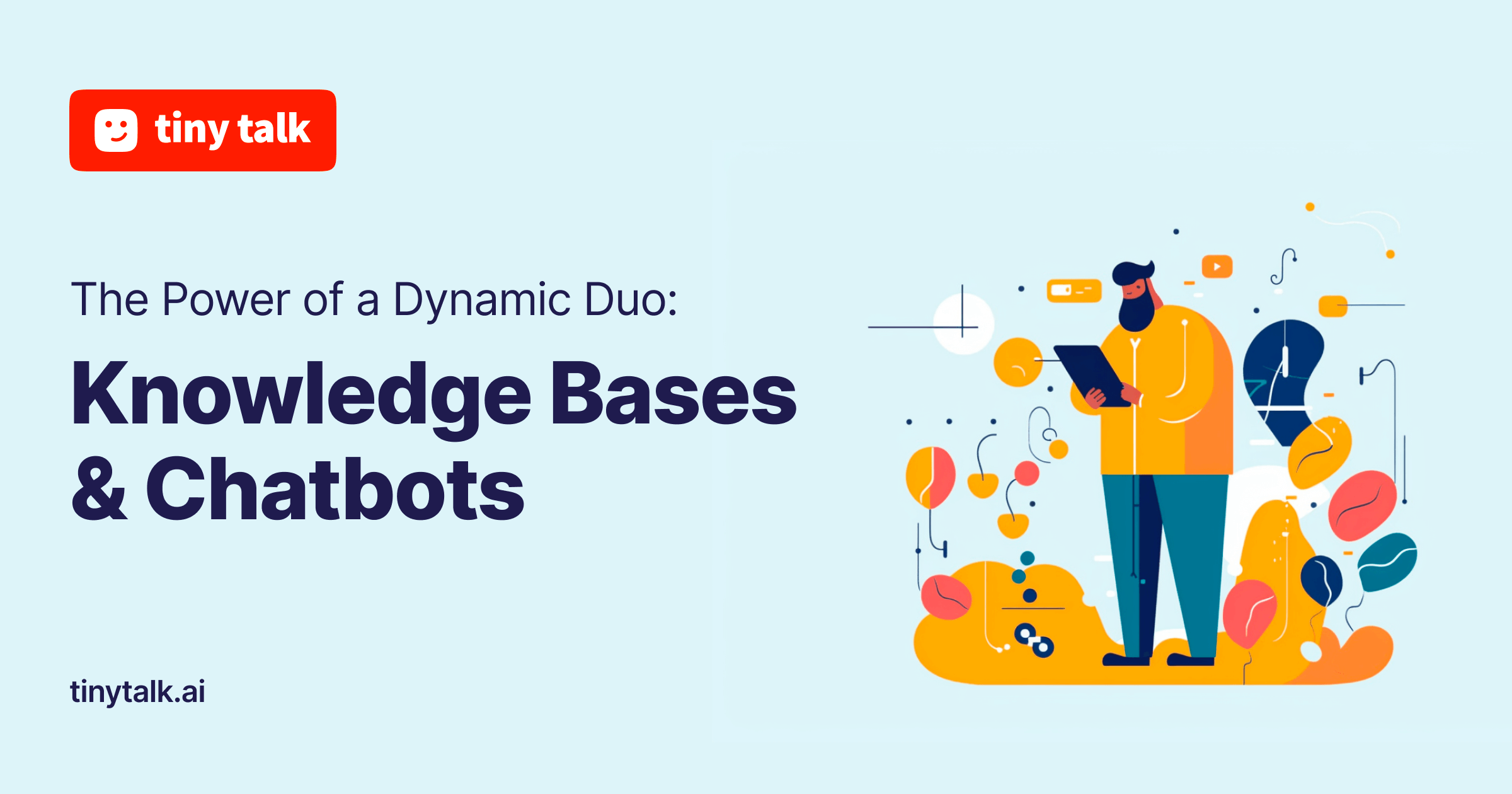Welcome to the forefront of digital transformation, where knowledge bases and AI-driven chatbots are reshaping the way businesses engage with their audience.
This article explores the transformative power of this dynamic duo, revolutionizing customer support and streamlining internal processes while empowering teams.
Join us to explore how businesses can harness the potential of AI technology to drive efficiency, enhance user experiences, and unlock new levels of innovation across various facets of their operations.
What Is A Helpdesk Knowledge Base?
A helpdesk knowledge base acts as a digital library where businesses store crucial information, such as FAQs, user manuals, troubleshooting guides, and policy details. This resource is designed to help customers solve problems independently by providing them with easy access to information. It's an invaluable tool for reducing support tickets and empowering users with self-service options.
Why a Helpdesk Knowledge Base Is Important?
A helpdesk knowledge base is pivotal for streamlining customer support, offering a self-service solution that empowers customers while reducing the strain on support teams. It serves as a centralized hub of information, enabling customers to easily find solutions anytime, which boosts satisfaction by providing immediate help without the need for direct interaction with support staff.
Centralized and Accurate Information:
A comprehensive knowledge base ensures that all information, whether for internal use by agents or external use by customers, is centralized, accurate, and easily accessible. This removes any ambiguity and speeds up the resolution process by avoiding repetitive questions and providing consistent answers.
Support for Multiple Knowledge Bases:
The ability to support multiple knowledge bases allows organizations to cater to different departments, teams, or customer segments. This ensures that the information is relevant and easily accessible by the appropriate users, thereby maximizing the benefits of the helpdesk knowledge base.
Streamlining Support Processes:
Integrating helpdesk knowledge bases can significantly streamline support processes. This enables customers to access information directly, reducing response times of agents and improving customer satisfaction by ensuring quicker resolution of issues.
Scalability:
Knowledge bases provide high-quality support at scale. They enable companies to maintain high standards of support even as the customer base grows, by allowing users to self-serve their problems, thereby reducing the volume of support requests and freeing up your team to focus on more complex issues.
Customer Satisfaction and Retention:
A well-maintained knowledge base can significantly improve customer satisfaction and retention. By enabling customers to quickly and easily find answers on their own, you empower them and provide a positive self-service experience, which in turn fosters loyalty and encourages long-term customer relationships.
Internal Efficiency and Training:
Internal knowledge bases enhance organizational efficiency and efficacy by guiding staff to follow established protocols and offering a standardized solution to common requests. They serve as an invaluable onboarding and training tool, reducing costs and improving productivity.
Knowledge Preservation and Consistency:
Helpdesk knowledge bases help in preserving valuable organizational knowledge, ensuring that it is not lost when employees leave or are unavailable. This leads to consistency in communication, as all team members have access to the same information, ensuring a unified customer experience.
How to Create Helpdesk Knowledge Base Content
Creating effective knowledge base content starts with understanding your customers' common questions and issues. Each article should be concise, easy to understand, and directly address the problems your customers might face. Here are some key components for helpdesk knowledge base content.
1. Identify Audience Needs:
- Understand your audience - who are the users accessing the knowledge base? What are their skill levels, technical expertise, and common issues they encounter?
2. Define Content Categories:
- Organize your knowledge base into logical categories or topics that align with common user queries or issues.
- Example categories might include account management, troubleshooting, product features, FAQs, etc.
3. Gather Information:
- Collect information from subject matter experts, product documentation, previous support tickets, and customer feedback.
- Ensure accuracy and relevance of the information gathered.
4. Create Clear and Concise Content:
- Write articles using simple language and clear instructions.
- Break down complex processes into step-by-step guides with screenshots or videos if applicable.
- Use bullet points, numbered lists, and headers to improve readability.
5. Address Common Issues:
- Identify common problems or questions users encounter and prioritize content creation accordingly.
- Provide solutions or workarounds for known issues.
6. Keep Content Updated:
- Regularly review and update articles to reflect changes in products, services, or processes.
- Ensure that all information is current and relevant.
7. Include Visual Aids:
- Incorporate screenshots, diagrams, or videos to visually demonstrate concepts or procedures.
- Visual aids can enhance understanding and make instructions easier to follow.
8. Make it Searchable:
- Implement a search feature that allows users to quickly find relevant articles.
- Use relevant keywords and tags to improve searchability.
9. Test and Iterate:
- Test the usability of the knowledge base with actual users and gather feedback.
- Iterate on the content based on user insights to improve effectiveness.
Knowledge Base Management and Best Practices
To ensure your knowledge base remains a valuable resource, regular updates and management are necessary. This includes revising articles to keep them current, using analytics to understand what your customers are searching for, and continuously improving the content based on user feedback. Encouraging customer interaction through ratings or comments can provide insights into how useful they find the information and what could be improved.
Benefits of Creating a Helpdesk Knowledge Base Chatbot
Artificial intelligence chatbots like Tiny Talk, are reshaping the landscape of helpdesk knowledge bases, ushering in an era of intelligent and efficient customer support. Integrating an AI powered chatbot with your knowledge base can significantly enhance the customer support experience. AI Chatbots, like Tiny Talk, provide instant responses to common queries by accessing the vast information within the knowledge base, reducing wait times and improving customer satisfaction. They can also handle multiple queries simultaneously, ensuring efficient support even during peak times. Chatbots can collect data on customer interactions, offering valuable insights into common issues and potential improvements for both the knowledge base and overall service.
Here's how AI-driven chatbots are shaping the future landscape of knowledge bases:
1. Conversational AI Advancements:
- AI chatbots evolve rapidly, leveraging advancements in natural language processing (NLP) and machine learning (ML) to deliver more human-like interactions.
- Future chatbots exhibit enhanced understanding of context, intent, and sentiment, enabling more natural and engaging conversations with users.
2. Personalized Assistance:
- AI-powered chatbots offer increasingly personalized support experiences by leveraging data analytics and customer profiling.
- Chatbots tailor responses and recommendations based on individual preferences, past interactions, and user behavior, fostering stronger customer relationships.
3. Multi-Channel Accessibility:
- AI chatbots seamlessly integrate with a wide range of communication channels, including websites, mobile apps, messaging platforms, and voice assistants.
- Users enjoy consistent support experiences across multiple channels, with chatbots adapting their behavior and responses to suit each platform.
4. Predictive Problem Resolution:
- AI chatbots anticipate user needs and proactively offer assistance before customers realize they need help.
- By analyzing historical support data and user patterns, chatbots predict potential issues and provide preemptive solutions, minimizing downtime and frustration.
5. Continuous Learning and Improvement:
- AI chatbots continuously learn from user interactions and feedback, enhancing their knowledge base and conversational capabilities over time.
- Through machine learning algorithms, chatbots adapt to new scenarios, refine their responses, and stay up-to-date with evolving products and services.
6. Human-Agent Collaboration:
- Helpdesk knowledge bases feature seamless collaboration between AI chatbots and human agents, blending automation with human expertise.
- Chatbots triage inquiries, escalate complex issues to human agents when necessary, and provide agents with relevant information to expedite resolution.
7. Augmented Intelligence:
- AI chatbots augment the capabilities of human agents by automating routine tasks, providing real-time insights, and facilitating more efficient support workflows.
- Human agents focus on higher-value interactions that require empathy, creativity, and critical thinking, while chatbots handle repetitive queries.
The Dynamic Duo of Knowledge Bases and Chatbots
A helpdesk knowledge base, enriched with carefully crafted content and supported by automated chatbots, can transform the customer support experience. It facilitates self-service and also streamlines support operations, making it an essential asset for any business aiming to improve service efficiency and customer satisfaction. By focusing on creating detailed, user-friendly content and leveraging the power of automation, businesses can provide exceptional support without overwhelming their teams.
Maximizing Your Knowledge Base’s Impact with Tiny Talk
We invite you to explore the possibilities with Tiny Talk and discover how easy it is to enhance your customer support system with a custom AI chatbot tailored to your needs.
Sign up Tiny Talk today and build and deploy your AI powered chatbot trained on your knowledge base in minutes!


